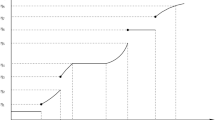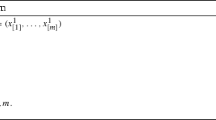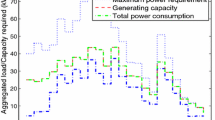Abstract
Recursive separable programming algorithms based on local, two-segment approximations are described for the solution of separable convex programs. Details are also given for the computation of lower bounds on the optimal value by both a primal and a dual approach, and these approaches are compared. Computational comparisons of the methods are provided for a variety of test problems, including a water supply application (with more than 600 constraints and more than 900 variables) and an econometric modelling problem (with more than 200 variables).
Similar content being viewed by others
References
A. Bachem, and B. Korte, “Quadratic programming over transportation polytopes”, Report No. 7767-OR, Institute für Okonometrie and Operations Research (Bonn, 1977).
E.M.L. Beale,Mathematical programming in practice (Sir Isaac Pitman & Sons Ltd., London, 1968).
D.P. Bertsekas, “On the Goldstein-Levitin-Poljak gradient projection method”,IEEE Transactions on Automatic Control 21 (1976) 174–184.
G.H. Bradley, G.G. Brown and G.W. Graves, “Design and implementation of large scale primal transshipment algorithms”,Management Science 24 (1977) 1–34.
M. Collins, L. Cooper, R. Helgason, J. Kennington and L. LeBlanc, “Solving the pipe network analysis problem using optimization techniques”,Management Science 24 (1978) 747–760.
R. Dembo and J. Klincewicz, “An approximate second order algorithm for network flow problems with convex separable costs” Series No. 21, School of Business, Yale University (New Haven, CT, 1978).
A.M. Geoffrion, “Objective function approximations for mathematical programming”.Mathematical Programming 13 (1977) 23–27.
M.D. Grigoriadis and T. Hsu. “RNET: The Rutgers minimum cost network flow subroutines”,SIGMAP Bulletin (1979) 17–18.
C.Y. Kao and R.R. Meyer, “Secant approximation methods for convex optimization”,Mathematical Programming Study 14 (1981) 143–162.
R.R. Meyer, “A class of nonlinear integer programs solvable by a single linear program”,SIAM Journal on Control and Optimization 15 (1977) 935–946.
R.R. Meyer, Two-segment separable programming,Management Science 25 (1979) 385–395.
R.R. Meyer. “Computational aspects of two-segment separable programming”, University of Wisconsin-Madison Computer Sciences Department Technical Report No. 382 (Madison, WI, 1980).
R.R. Mayer, “Piecewise-linear approximation methods for optimization problems”, University of wisconsin-Madison Computer Sciences Department Technical Report, in preparation (Madison, WI, 1983).
R.R. Mayer and M.L. Smith, “Algorithms for a class of ‘convex’ nonlinear integer programs”, in: W.W. White, ed.,Computers and mathematical programming, National Bureau of Standards Special Publication 502 (Washington, DC, 1978).
H. Müller-Merbach, “Die methode der ‘direkten Koeffizientanpassung’ (μ-Form) des separable programming”,Unternehmensforschung 14(3) (1970) 197–214.
R.T. Rockafellar,Optimization in networks, Lecture notes, Department of Mathematics, University of Washington (Seattle, WA, 1976).
T.L. Saaty,Optimization in integers and related extremal problems (McGraw-Hill, New York, 1970).
J.Z. Teng, “Exact distribution of the Kruskal-Wallis H test and the asymptotic efficiency of the Wilcoxon test with ties”, Ph.D. Thesis, University of Wisconsin (Madison, WI, 1978).
L.S. Thakur, “Error analysis for convex separable prorams: The piecewise linear approximation and the bounds on the optimal objective value”,SIAM Journal on Applied Mathematics 34 (1978) 704–714.
Author information
Authors and Affiliations
Additional information
Research supported by National Science Foundation Grants MCS74-20584 A02 and MCS-7901066.
Rights and permissions
About this article
Cite this article
Meyer, R.R. Computational aspects of two-segment separable programming. Mathematical Programming 26, 21–39 (1983). https://doi.org/10.1007/BF02591890
Received:
Revised:
Issue Date:
DOI: https://doi.org/10.1007/BF02591890




